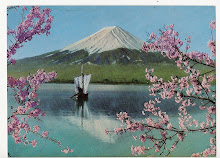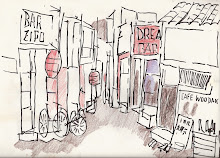 My previous post was all about my flight from San Francisco to Tokyo, the stopover in Hawaii, the sight of Midway island pointed out by the Captain. The significance of that battle would not really make an impact on me until I was much older. Sure, I knew there was one major air battle there, but what was important at that time was that America had won the war and Japan was reputed to be one great duty station. As a 19 year old youth, the thought of enjoying the excitement of the Orient had created some exciting images in my imagination. And now, many years afte that tour of duty ended, I realize that those images were, in fact, exciting in a way that only those who spent time stationed in Japan would ever be able to imagine. Sure, there were the stories the sailors who sailed into Japan told. Most were pretty exciting, but their time in Japan was limited to the time their floating duty station spent. There was always a massive amount of sailors from the various carriers and tincans that were tied up at the Yokuska Naval Station. Their duration of time spent in Japan was usually about two weeks. They were called "Westpac cruises." Being stationed at a permanent station was really the envy of most of the ocean-going navy. Looking back, I realize exactly what a great opportunity it was; looking back, I have regrets that I didn't spend more time learning about the country, taking tours and shooting many more photos and slides. Nevertheless, I had a great time. The twenty-eight months spent in Japan has supplied me with a lifetime of fond memories.
My previous post was all about my flight from San Francisco to Tokyo, the stopover in Hawaii, the sight of Midway island pointed out by the Captain. The significance of that battle would not really make an impact on me until I was much older. Sure, I knew there was one major air battle there, but what was important at that time was that America had won the war and Japan was reputed to be one great duty station. As a 19 year old youth, the thought of enjoying the excitement of the Orient had created some exciting images in my imagination. And now, many years afte that tour of duty ended, I realize that those images were, in fact, exciting in a way that only those who spent time stationed in Japan would ever be able to imagine. Sure, there were the stories the sailors who sailed into Japan told. Most were pretty exciting, but their time in Japan was limited to the time their floating duty station spent. There was always a massive amount of sailors from the various carriers and tincans that were tied up at the Yokuska Naval Station. Their duration of time spent in Japan was usually about two weeks. They were called "Westpac cruises." Being stationed at a permanent station was really the envy of most of the ocean-going navy. Looking back, I realize exactly what a great opportunity it was; looking back, I have regrets that I didn't spend more time learning about the country, taking tours and shooting many more photos and slides. Nevertheless, I had a great time. The twenty-eight months spent in Japan has supplied me with a lifetime of fond memories. This is a woodblock print I found on the internet. It's old. Sure, I wished I had the original to post, but I did manage to collect a few old prints. Where they are now, I'm not sure. I still have some storage spots with old artifacts and memoirs I have yet to open. Hopefully, they will be unharmed by the fifty plus years they have been stored in the cedar-lined trunks. I will be posting photos of these items as I find them. And I still have many slides to look at and sort. While I was stationed in Japan, I did a lot of sketching and painting, mostly tempra paints. Some of them are pretty decent; some are simply magic marker type of expressions of sake shops and sake bottles, drawings of bar scenes and people in general. There was a time while stationed in Japan when, just for the fun of it, I painted the outside facades of favorite bars, bought a frame, framed the picture and presented it to the owner. There was a real feeling of glee when I walked in a few days later and saw my painting on the wall behind the bar. I wonder how many are still hanging there? Honestly, I doubt there is one bar of the many I entered that still remains open. The group photo above is an official U.S.Navy photograph of those in our squadron who were advanced to E-5 on the 16th of November 1962. I am in the middle of the first row. I felt pretty good, advancing to E-5 at only 20 years of age. It meant a lot more responsibility, more pay, and a lot more privileges.
This is a woodblock print I found on the internet. It's old. Sure, I wished I had the original to post, but I did manage to collect a few old prints. Where they are now, I'm not sure. I still have some storage spots with old artifacts and memoirs I have yet to open. Hopefully, they will be unharmed by the fifty plus years they have been stored in the cedar-lined trunks. I will be posting photos of these items as I find them. And I still have many slides to look at and sort. While I was stationed in Japan, I did a lot of sketching and painting, mostly tempra paints. Some of them are pretty decent; some are simply magic marker type of expressions of sake shops and sake bottles, drawings of bar scenes and people in general. There was a time while stationed in Japan when, just for the fun of it, I painted the outside facades of favorite bars, bought a frame, framed the picture and presented it to the owner. There was a real feeling of glee when I walked in a few days later and saw my painting on the wall behind the bar. I wonder how many are still hanging there? Honestly, I doubt there is one bar of the many I entered that still remains open. The group photo above is an official U.S.Navy photograph of those in our squadron who were advanced to E-5 on the 16th of November 1962. I am in the middle of the first row. I felt pretty good, advancing to E-5 at only 20 years of age. It meant a lot more responsibility, more pay, and a lot more privileges.
MY ENCHANTMENT WITH THE NIGHT SPOTS QUICKLY WANED AND I FIGURED I NEEDED TO SPEND MY TIME IN A LITTLE MORE WORTHWHILE MANNER.
It all depends on who a guy hangs out with that matters. This begins early in life and continues right on through the elder years. Upon my arrival, I met a lot of different guys from all over the USA. "Where you from, Huff?" was the initial question. Back in the 60s, where one hailed from seemed to make a bigger difference than it does in today's armed forces. How do I know this? Simply through conversation with a few guys who have been fighting in Iraq and Afghanistan.
WHAT DIFFERENCE DOES IT MAKE WHERE ONE IS FROM IN THE SERVICE?
Why did it make a difference where a guy was from? I thought about this while writing and reflected on this question. It is a question that most likely goes back into our primal beginnings. Speaking from a contemporary view back in the 60s, where one was from probably reflected one's assumed values and standards about just about everything that affected life in the USA fifty years ago. So where was I from? Actually, I had two answers for that question. To go back to my basic roots, I was born in Colorado, a native Coloradian (Coloradoian?). "Born in Colorado, grew up in Kansas City and joined the Navy in California.
I MADE A LOT OF FRIENDS WHILE I WAS IN THE NAVY. I DIDN'T REALLY FIT INTO ANY CERTAIN GROUP BUT SEEMED TO BE WELCOME IN WHATEVER GROUP I WAS WITH AT THE TIME. My first liberty in Japan was spent with some guys from the south; there was Blankenship from Tennessee, Crow from Mississippi, Guillory from Louisiana and a guy named Lambert. He hailed from West Virginia--not Virginia!It was a rip-roaring liberty, a little too roudy for me. There was way too much chatter about the Confederates, Dixie and all of the other subject matter that accompanies conversations of this genre. Nevertheless, I drank my share of Suntory Whiskey and Kirin Beer and probably agreeded with most everything that was said. Mostly, the conversation gradually went from bad to worse; once the political text of the chatter ended with a loud rebel yell or two, the main subject became the difference between American women and Japanese women. It was usually at this point in the conversation that I bowed out and sought the company of one of many of the young and appealing ladies. The dollar had a lot of purchase power in 1961; there was 360 yen to the dollar. Friendship was easily purchased for short-term relationships. And I got really too bored to remain with my buddies for the rest of the night. Besides, midnight was the hour we had to be back to base on weekday liberties; weekend liberty was another matter. Usually, one could leave on Friday at 1600 hours and not have to return until 0800 Monday mornings. Now, about that Petri camera I purchased at the Navy PX. It was a dandy and had an automatic setting. It also had an electric eye that helped me shoot some pretty decent shots without worrying about F-stops and speeds. Somewhere in my stuff from a tour of duty from long ago are boxes of slides I took; I am hoping they will still be good. Fifty years, however, is a long time for a slide to sit in a yellow kodachrome box. I must check on these soon. Yes, I loved my Petri and began shooting pictures of lots of different subjects. Pagodas became tiring; shrines became too numerous. And at the time, shooting shrines didn't seem right. Was it a religious conflict? It might have been. Isn't it odd we have some weird ideas about false idols and forget about the sins of the flesh.? It could be rationalized and blamed on youth and the fires of Spring. The Fires of Spring was a James Mitchener book I read. But Sayonara was another one of his books. It would be awhile before the Sayonara stage of my tour began.













